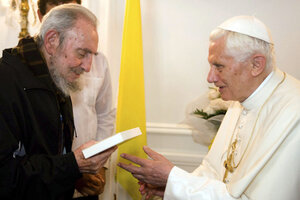Fidel Castro, excommunicated in 1962, meets with Pope Benedict
Former Cuban leader Fidel Castro, who once outlawed religion, met with Pope Benedict XVI today. Benedict's visit is part of a new Catholic strategy in a changing Cuba.

Pope Benedict XVI meets former Cuban leader Fidel Castro in Havana on March 28.
Alex Castro/Reuters
Mexico City and Havana
When the late pope John Paul II met with Fidel Castro in Cuba in 1998, the church had high hopes it could help bring fast political change to the island, as his visit had to his native Poland.
That never happened. Poland is a far more Catholic country than Cuba, which was once officially atheist. Only half of Cubans identify as Catholic today, according to Pew, and fewer than 10 percent actually practice.
Nearly 15 years later, as Pope Benedict XVI wraps up a three-day trip to the island, the church is “wiser about the limits of its own ability to catalyze rapid change in Cuba,” says William LeoGrande, a Cuba expert at American University.
Instead, he says, the trip – including the visit with Fidel Castro – simply reinforces the strategy the Cuban church has been pursuing: A careful relationship with the government that pushes for more openness and human rights without veering into overt opposition. And while the visit with Fidel Castro lends the former head of state, and his brother and successor Raul Castro, an air of legitimacy, it also underscores how much more of a voice the church has today.
“[The visit with Fidel Castro] is more of a courtesy than it is anything else,” Mr. LeoGrande says. “Fidel really has been out of the decision making process in any formal way for almost six years now.” In that time, he says, "the church has [developed] much more of a political and social role."
In a public Mass today, the pope denounced religious intolerance in general and later specifically urged more public space for the Cuban Catholic Church. "It must be said with joy that in Cuba steps have been taken to enable the church to carry out her essential mission of expressing her faith openly and publicly," he said. "Nonetheless this must continue forward" for the good of Cuban society.
The pope's visit, his first to Spanish-speaking Latin America, started in Mexico. He arrived in Cuba on Monday to celebrate the 400th anniversary of Cuba's patron saint, Our lady of Charity el Cobre.
Raul reaches out
After the Cuban Revolution, Fidel Castro declared Cuba an atheist state and exiled priests or sent them to “reeducation camps.” It wasn't until the Soviet Union fell, ending the subsidies that long buoyed Cuba, that Fidel made gestures toward the Vatican. Pope John Paul II's 1998 visit was considered a landmark.
Under President Raul Castro the church, led by Cardinal Jaime Ortega, has taken on even more of a public role. It has helped broker the release of political prisoners and has taught university courses in economics for Cubans who are now small business owners under economic changes allowed by President Castro.
Such efforts “allow it to become a figurehead or presence in terms of social rights and justice on the island,” says Michelle Gonzalez, a religious studies professor at the University of Miami. She says the pope's visit to the island nation reflects an “intentional decision to visit a country where the Catholic Church is actually thriving in ways it has not in decades.”
The benefits for the Cuban leadership are clear. A visit by someone who “represents a broad swath of humanity,” says Ted Henken, a professor at Baruch College at The City University of New York, is “partly meant to legitimize them in public opinion.”
In Havana, some dismiss the notion that politics are behind the visit. "This is a pastoral visit, not a political one,” says Evelio, an elderly man who declined to give his last name. He was in the same Revolution Plaza in 1998 when John Paul II visited Havana. On the front of a straw hat, he pinned a newspaper photo of Fidel Castro greeting the last pope.
But others hold high expectations that the visit could usher in more changes. While the visit of John Paul II didn't change the political system, it did eventually open the government to more dialogue with the church. “There's conversations with the state that before would not have happened,” says Maira Bisciedo, 60, who, along with three friends wore white Pope Benedict XVI t-shirts and caps. “I hope there'll be changes after this visit."

